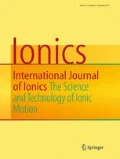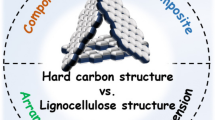Abstract
Polysaccharide-based biopolymers have gained much attention in electrochemical devices recently. Tamarind seed polysaccharide (TSP) is a biopolymer obtained from the extract of tamarind seed. It is used as thickening and gelling agent in food and textile industries. There are no works in polymer electrolytes based on TSP in lithium-ion conducting membranes. A pure TSP membrane has been prepared by dissolving 1 g of TSP in distilled water by using solution-casting technique. The prepared biopolymer membranes are subjected to Fourier transform infrared (FTIR), X-ray diffraction (XRD), and AC-impedance techniques. FTIR analysis has been conducted to observe the possible interaction between the polymer and lithium salt based upon the changes in wave numbers of the peaks. The nature of the membrane (crystalline or amorphous) has been revealed by XRD. The electrical properties of the membranes have been analyzed by AC-impedance spectroscopy. The maximum ionic conductivity for the salt-doped membrane 1 g TSP:0.4 g lithium bromide (LiBr) has been found to be 4.83 × 10−4 S cm−1. The primary lithium-ion battery has been constructed using the best conductivity membrane, and the open circuit voltage (OCV) has been observed as 1.63 V.









Similar content being viewed by others
References
Goodenough JB, Kim Y (2011) Challenges for rechargeable batteries. J Power Sources 196:6688–6694
Wu H, Cui Y (2012) Designing nanostructured Si anodes for high energy lithium ion batteries. Nano Today 7:414–429
Bouchet R, Maria S, Meziane R, Aboulaich A, Lienafa L, Bonnet JP, Trang NTP, Bertin D, Gigmes D, Devaux D (2013) Single-ion BAB triblock copolymers as highly efficient electrolytes for lithium-metal batteries. Nat Mater 12:452–457
Denoyel R, Armand M, Fergus JW (2010) Ceramic and polymeric solid electrolytes for lithium-ion batteries. J Power Sources 195:4554–4569
Quartarone E, Mustarelli P (2011) Electrolytes for solid-state lithium rechargeable batteries: recent advances and perspectives. Chem Soc Rev 40:2525–2540
Smith DM, Dong B, Marron RW, Birnkrant MJ, Elabd YA, Natarajan LV, Tondiglia VP, Bunning TJ, Li CY (2011) Tuning ion conducting pathways using holographic polymerization. NanoLett 12:310–314
Rajeswari N, Selvasekarapandian S, Karthikeyan S, Nithya H, Sanjeeviraja C (2012) Lithium ion conducting polymer electrolyte based on poly (vinyl alcohol)–poly (vinyl pyrrolidone) blend with LiClO4. Int J Polym Mater Polym Biomaterial 61(14):1164–1175
Huang B, Wang Z, Li G, Huang H, Xue R, Chen L, Wang F (1996) Lithium ion conduction in polymer electrolytes based on PAN. Solid State Ionics 85:79–84
Francis KMG, Subramanian S, Shunmugavel K, Naranappa V, Pandian SSM, Nadar SC (2016) Lithium ion-conducting blend polymer electrolyte based on PVA–PAN doped with lithium nitrate. Polym-Plast Technol Eng 55:25–35
Majid SR, Arof AK (2005) Proton-conducting polymer electrolyte films based on chitosan acetate complexed with NH4NO3 salt. Phys B Condens Matter 355:78–82
Azizi Samir MAS, Chazeau L, Alloin F, Cavaillé J-Y, Dufresne A, Sanchez J-Y (2005) POE-based nanocomposite polymer electrolytes reinforced with cellulose whiskers. Electrochim Acta 50:3897–3903
Ahmad Khiar AS, Arof AK (2010) Electrical properties of starch/chitosan-NH4NO3 polymer electrolyte. Ionics 16:123–129
Osman Z, Ibrahim ZA, Arof AK (2001) Conductivity enhancement due to ion dissociation in plasticized chitosan based polymer electrolytes. Carbohydr Polym 44:167–173
Andrade JR, Raphael E, Pawlicka A (2009) Plasticized pectin-based gel electrolytes. Electrochim Acta 54:6479–6483
Raphael E, Avellaneda CO, Manzolli B, Pawlicka A (2010) Agar based films for application as polymer electrolytes. Electrochim Acta 55:1455–1459
Dragunski DC, Pawlicka A (2002) Starch based solid polymeric electrolytes. Mol Cryst Liq Cryst 374:561–568
Hodge RM, Edward GH, Simon GP (1996) Water absorption and states of water in semicrystalline poly(vinyl alcohol) films. Polymer 37:1371–1376
Hashmi SA, Kumar A, Maurya KK, Chandra S (1993) Proton-conducting polymer electrolyte. I. The polyethylene oxide + NH4ClO4 system. J Phys D Appl Phys 23:1307
Boukamp BA (1986) A non-linear least squares fit procedure for analysis of immittance data of electrochemical systems. Solid State Ionics 20:31–44
Rajendran S, Uma T (2000) Experimental investigations on PVC–LiAsF6–DBP polymer electrolyte systems. J Power Sources 87:218–222
Chiam-Wen L, Ramesh S, Ramesh K, Arof AK (2012) Preparation and characterization of lithium ion conducting ionic liquid-based biodegradable corn starch polymer electrolytes. J Solid State Electrochem 16:1869–1875
Premalatha M, Vijaya N, Selvasekarapandian S, Selvalakshmi S (2016) Characterization of blend polymer PVA-PVP complexed with ammonium thiocyanate. Ionics 22(8):1299–1310
Aziz NAN, Idris NK, Isa MIN (2010) Proton conducting polymer electrolytes of methylcellulose doped ammonium fluoride: conductivity and ionic transport studies. J PhysSci 5:748–752
Agrawal RC, Hashmi SA, Pandey GP (2007) Electrochemical cell performance studies on all-solid-state battery using nano-composite polymer electrolyte membrane. Ionics 13:295–298
Monisha S, Mathavan T, Selvasekarapandian S, Milton Franklin Benial A, Prema Latha M (2016) Preparation and characterization of cellulose acetate and lithium nitrate for advanced electrochemical devices. Ionics. doi:10.1007/s11581-016-1886-8
Author information
Authors and Affiliations
Corresponding authors
Rights and permissions
About this article
Cite this article
Premalatha, M., Mathavan, T., Selvasekarapandian, S. et al. Tamarind seed polysaccharide (TSP)-based Li-ion conducting membranes. Ionics 23, 2677–2684 (2017). https://doi.org/10.1007/s11581-017-1989-x
Received:
Revised:
Accepted:
Published:
Issue Date:
DOI: https://doi.org/10.1007/s11581-017-1989-x




